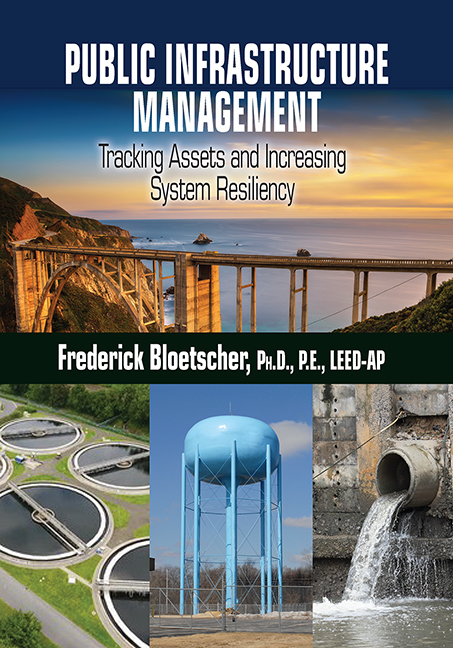Public Infrastructure Management
$99.95
Tracking Assets and Increasing System Resiliency
Frederick Bloetscher, Ph.D., P.E., Leed-AP
Hardcover, 7×10, 522 pages
ISBN: 978-1-60427-139-3
October 2019
Description
This book addresses the long-term maintenance, repair, and replacement of public infrastructure in a practical, cost effective manner—something that is missing in the current literature. Fixing our public infrastructure is essential for public health and safety and is fast becoming a national priority. This title provides an overview of the major public works infrastructure systems (water, sanitary sewer, stormwater, roads, bridges, and railways), including components, operational goals, maintenance, areas where failure can occur, and ways to address failure. Risk and vulnerability to these systems are evaluated and guidance on how to create a condition index (assessment), given limited data, is provided. It also includes statistical methods to make an assessment more robust. Recommendations on budgeting strategies and capital planning are also discussed and designed to bring the risk, vulnerability, and condition indices together into a thorough decision-making process. It is a must read for anyone involved in public infrastructure management, including professional civil and environmental engineers, utility managers, local government managers and officials, urban and regional planners, and civil and environmental engineering students.
Key Features
- Presents an overview of the components and maintenance needs of major public infrastructure systems
- Outlines practical methods to gather data to assess the condition of each infrastructure system and tools to generate relevant data
- Provides ways to evaluate risk and vulnerability in asset management and how to streamline the decision-making processes
- Discusses the funding and prioritization of capital improvement projects within infrastructure systems
- Expands on the use of work orders and repairs to improve information about each system
- Includes critical case studies from around the United States where public infrastructure has failed, followed by the lessons learned
- Features over 200 color figures and 75 tables to illustrate major points throughout the book, including the components of public water, sanitary sewer, and stormwater management systems
- WAV contains instructor materials for adopting professors, including a proposed syllabus for the course, 15 PowerPoint lectures covering chapters 2 through 16, end-of-chapter homework questions and answers, project ideas for the instructor, GIS data sets for students to do their own condition assessments, and sample final and midterm exams—available from the Web Added ValueTM Download Resource Center at www.jrosspub.com
About the author(s)
Frederick Bloetscher, Ph.D., is currently a Professor of Civil, Environmental & Geomatics Engineering and Associate Dean for Undergraduate Studies and Community Outreach at Florida Atlantic University in Boca Raton, Florida. His research focus has been on urban infrastructure systems, particularly public water, stormwater, and sewer systems and their sustainability. Dr. Bloetscher teaches the capstone senior design sequence at FAU, plus classes in water/wastewater, construction, environmental engineering and modeling, hydraulics, and infrastructure management. He is also the author of Practical Concepts for Capstone Design Engineering.
Dr. Bloetscher received his bachelor’s degree in civil engineering from the University of Cincinnati and earned his Master of Public Administration Degree from the University of North Carolina at Chapel Hill. His Ph.D. is in civil, environmental, and architectural engineering from the University of Miami. His experience prior to academia is helpful to his ongoing research and outreach efforts. He was a city manager for two communities in North Carolina that were undergoing significant infrastructure improvements. In Florida, he was a utility director and deputy director for several large water and sewer systems that included groundwater, aquifer storage, reclaimed water systems, wastewater plants, and miles of piping that needed to be maintained.
Dr. Bloetscher has many years of consulting experience as well. He is the President of Public Utility Management and Planning Services, Inc. (PUMPS), a company dedicated to the evaluation of utility systems, needs assessments, condition assessments, strategic planning, capital improvement planning, grant and loan acquisition, inter-local agreement recommendations, bond document preparation, consultant coordination, permitting, and implementation of capital improvement construction. In managing both large and small infrastructure systems, and consulting for local governments, he has been involved in the construction of over $500 million in improvements—both new for expansion and for replacement.
Dr. Bloetscher has volunteered his time for many professional associations. He is the former Chair for the Water Resource Division Trustees, 3-time Chair of the Groundwater Resource Committee, and a member of the aquifer storage and recovery sub-committee and the Education Committee for the American Water Works Association (AWWA). Currently, Dr. Bloetscher is the chair of the distribution engineering and construction committee for AWWA and a former member of AWWA’s Technical and Education Council. He is the Secretary for the Florida Section of AWWA and has been the technical program chair since 2004. He is a LEED-AP and holds professional engineering licenses in nine states, and operations licenses in water, wastewater, distribution, and collection systems. He has had a North Carolina General Contractor’s license for pipeline and small utility construction for over 20 years.
Dr. Bloetscher has been nominated for the “Distinguished Teacher of the Year” award a number of times by his students at FAU and has received three university-wide leadership awards including the prestigious “Presidential Award for Community Engagement” in 2018, received several national awards including the “Distinguished Educator Award” from the National Engineers Council in 2017, and has been recognized by the AWWA, the National Engineer’s Council, Florida Section of AWWA, and local chapters of ASCE for his contributions to the industry. In 2012, Dr. Bloetscher received the “National Council of Examiners for Engineering and Surveying Award for Connecting Professional Practice and Education” for his work on the Dania Beach Nanofiltration Facility, which is the first LEED-Gold water treatment facility in the world. Dr. Bloetscher was the LEED administrator for the project.
Dr. Bloetscher can be contacted via email at h2o_man@bellsouth.net. His website is www.h2o-pe.com and his blog is at publicutilitymanagment.com on WordPress.
Table of Contents
SECTION I: INFRASTRUCTURE: A COMPREHENSIVE OVERVIEW
Chapter 1: History of Infrastructure
Chapter 2: Economic Impact of Infrastructure
Chapter 3: Public Water Systems
Chapter 4: Sanitary Sewer Systems
Chapter 5: Stormwater Management Systems
Chapter 6: Transportation Systems (Roads and Railroads)
SECTION II: ASSESSING ASSETS
Chapter 7: Asset Management
Chapter 8: Valuation
Chapter 9: Vulnerability and Risk Management
Chapter 10: Creating a Condition Assessment
Chapter 11: Financial Resources for Repair and Replacement
Chapter 12: Operating Environment
Chapter 13: Life Cycle Cost Analysis
SECTION III: THE FUTURE, BASED ON AVOIDING THE PAST
Chapter 14: What Could Possibly Go Wrong?
Chapter 15: Sustainability of Infrastructure – Looking at the Long-term Future Trends
Chapter 16: Leadership
Chapter 17: Conclusions
Index
Reviews
“The arc of Dr. Bloetscher’s career spans from research to practice, and he brings keen insight from his wide-ranging experiences to bear on the complex challenges of infrastructure asset management. As climate change and shifting populations bring greater stress to water resources and systems, leaders and decision makers need to ensure the vital water systems that support our communities, industries, and the environment remain safe and sustainable. Dr. Bloetscher’s comprehensive book provides a detailed overview of urban and rural water systems as well as helpful guidance for those charged with safeguarding public health and strengthening their communities. As water works operators and managers prepare for more extreme weather conditions, changing regulations, and elevated community expectations, this book can help them make our water works more resilient to environmental and financial shocks.”
—Kenneth Mercer, Ph.D., Editor-in-Chief, AWWA Water Science and Journal AWWA, American Water Works Association
“Public Infrastructure Management is an informative, comprehensive, well-researched and eye-opening discussion of the public’s role in supporting the infrastructure that is the basis of our economic welfare. It explains how infrastructure is built, breaks, and should be fixed. This book is a must read for everyone in public service.”
—William Y. Davis, Principal Planner, CDM Smith
“Public Infrastructure Management offers concise and useful information on some of the major public sector infrastructures associated with drinking water, wastewater, stormwater, and roadways. The information presented on the tracking and maintenance of these infrastructures through asset management, asset valuation, vulnerability and risk management, performance of condition assessment, securing financial resources, optimizing operation, and life-cycle analysis are user-friendly for students and practitioners who are interested, or currently engaged, in the management and operation of public sector infrastructures. In conjunction with other design standards, guidelines, and documents from professional organizations such as the American Water Works Association, this technical textbook is a valuable resource in educating existing and new public infrastructure professionals in the proper understanding and appreciation of capital planning, construction, operation, and maintenance to protect public health and enhance economic development at the community level.”
—Chi Ho Sham, Ph. D., Vice President and Chief Scientist, Eastern Research Group, Inc.
“I wish I had this book before I worked on our field asset condition assessment program, but I am glad I have it now as I move forward. It helps me better understand the data needed and the results expected as I work with our consultants, finance, public works, and public officials on asset management. Section II: Assessing Assets was most helpful in better understanding where to go from here with the asset management program. To quote the author “the adage that we can’t afford it simply ignores the fact that most communities cannot afford not to” is crystal clear from reading this book.”
—John Stubbart, Superintendent of Field O&M, Centennial Water and Sanitation District, Highlands Ranch, CO
“Dr. Bloetchser has created a comprehensive guide to public infrastructure asset management destined to become a useful tool well into the future for governmental entities and the consultants that support them.”
—Deborah Beatty, P.E., Chief Engineer, Tohopekaliga Water Authority, Kissimmee, FL
You may also like…
-

Plasticity for Structural Engineers
Retail Price: $64.95$54.95 Add to cart -

Limit Analysis and Soil Plasticity
Retail Price: $64.95$54.95 Add to cart -

Resilient Urban Drainage System Strategies for Extreme Weather
Retail Price: $99.95$89.95 Add to cart -

Practical Concepts for Capstone Design Engineering
Retail Price: $129.95$109.95 Add to cart -

Plasticity in Reinforced Concrete
Retail Price: $59.95$49.95 Add to cart
Related products
-

Intellectual Property for Integrated Circuits
Retail Price: $99.95$89.95 Add to cart -

Design of Column-Reinforced Foundations
Retail Price: $129.95$109.95 Add to cart -

Elastic Beam Calculations Handbook
Retail Price: $119.95$99.95 Add to cart -

Systems Engineering with Economics, Probability and Statistics
Retail Price: $99.95$89.95 Add to cart -

Semi-Rigid Connections Handbook
Retail Price: $189.95$169.95 Add to cart




